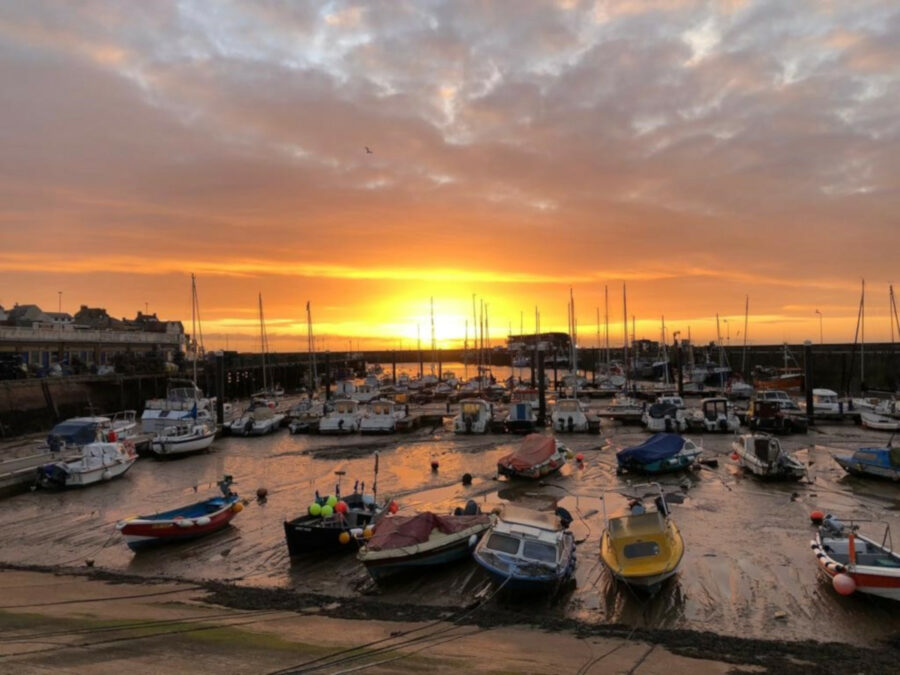A plan is in hand to raise the profile of the East Yorkshire port of Bridlington by linking its fishing industry to tourism, reports Tim Oliver
The development stems from a study carried out by Hull University, ‘Project Pincer 2’, commissioned by the North Eastern IFCA and funded by the Holderness Coast Fisheries Local Action Group (FLAG) to look at the future of the local lobster industry.
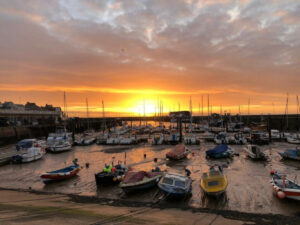
The East Yorkshire holiday resort and fishing port of Bridlington is aiming to brand itself the ‘lobster capital of Europe’, in a bid to boost tourism and the local economy. (Photo: HFIG)
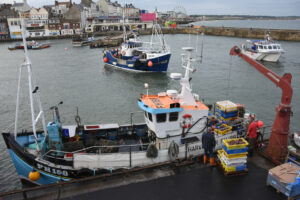
Landing shellfish on the fish quay on Bridlington’s South Pier.
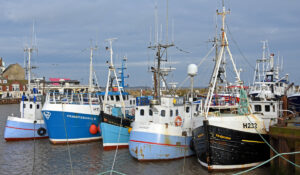
Bridlington is the hub port for the Holderness region, extending from Bridlington to the river Humber.
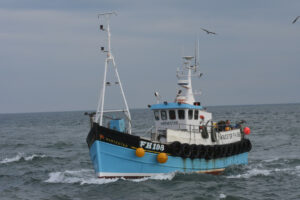
Harvester is one of Bridlington’s successful fleet of potting boats.

HFIG operates the 10.8m research catamaran RV Huntress, but now needs a bigger and faster vessel. (Photo: HFIG)

Facilities at the HFIG research laboratory on Bridlington’s South Pier. (Photo: HFIG)

Bridlington has a fleet of modern shellfish boats fishing for lobster, crabs and whelks.

The ban on landing berried lobsters, introduced in October 2017, has hit landings at Bridlington.
The FLAG covers the East Riding of Yorkshire, from Flamborough Head to Spurn Point on the Humber estuary.
Bridlington is the largest shellfish landing port in the UK, and is the hub of a major shellfish fishery for lobster, crabs and whelks carried out along the Holderness coast, including the smaller towns of Hornsea and Withernsea, where boats work from the beaches.
Lobster landings in 2018 were 300t worth £4.4m, according to MMO figures. Crab landings were 2,612t worth £5.4m, and 652t of whelks were landed, valued at £710,000.
The Hull University Business School study said there was scope to add value to the lobster catch, which is currently mostly exported live to France, Spain and Portugal, with little local processing.
Ray Williamson, regeneration and funding advisor at the FLAG, said that the Hull University study made a series of recommendations on adding value to the product, including more local processing, improved quality control, grading and business-to-business branding.
It also looked at the feasibility of developing local facilities for longer-term storage of lobsters, for two to three months, so they could be sold when market prices were strong. There are holding tanks now at Bridlington, but they allow storage for only a few days.
The report also suggests developing the domestic market more to reduce the current reliance on exports.
A major proposal in the study is that Bridlington should take advantage of its position as the largest lobster port in Europe to support and develop tourism in the region, as well as boost business.
“We’ve got an enormous lobster landing port, but we’re not making much of that. You go to the USA, Canada, Newfoundland, they’re all making a big thing about being a lobster capital,” said Ray Williamson.
“A group of local fishing industry representatives and academics went to Newfoundland in January to see how they do things there, and one of the places they visited was Shediac in New Brunswick. They call themselves the lobster capital of the world – they don’t land anything there, but they have an enormous processing industry – and they have built an enormous tourism industry on the back of that, with 300,000 visitors a year.
“We believe Bridlington can do the same, and we have set up a steering group of local stakeholders to take forward the recommendations in the study based around the concept, ‘Bridlington Bay – lobster capital of Europe’.
“I am currently preparing a five-year strategy to turn what we believe is an enormous but unexploited economic opportunity into a reality.”
Resistance
Ray Williamson said he expected there would be some resistance from the local industry to the plans, particularly to add more value and reduce exports.
“Until recently, there’s been a very lucrative export market paying very good money, so we’re not expecting that to change significantly, once we get over Covid and Brexit,” he said.
“We’re not expecting fishermen to suddenly start doing things completely differently, but nevertheless, I think they can see the potential, particularly with what’s going on now.
“So it’s about working with the sector, not just the catchers but also the processors and retailers, to develop first of all a quality product. A lot more can be done from the industry side with that, looking at branding, business-to-business branding and developing more of the domestic market, rather than purely just export.
“Ironically, the study, which was carried out last year before Covid-19, warned of the dangers of being too reliant on exports and not developing the domestic market.
“I expect there will be resistance – people get set in their ways, they don’t like change.”
He said it would require public sector investment to get the project going.
FLAG support for local industry
The Holderness Coast FLAG has invested £6.5m in the local fishing industry since 2011. Projects have included a lobster research facility on Bridlington’s South Pier, fishing compounds at Hornsea and Withernsea, and a slipway at Withernsea, as well as grants to individual fishermen and investment in tourism projects linked to the fishing industry.
The FLAG also provided assistance to the Holderness Fishing Industry Group (HFIG) to acquire and run its research boat Huntress. HFIG was originally set up to negotiate with wind farms on the interface between the offshore and fishing industries. It later set up a commercial arm and is now increasingly orientated towards marine and scientific services, as well as being a representative voice for the region’s fishing industry.
A recent major project for the FLAG has been setting up a popular health training facility in Bridlington.
“It was well received, and we’ve now got a mobile facility that travels along the coast offering a wide range of medical and health services that is exceptionally popular with the fishermen,” said Ray Williamson.
FLAGs have been financed by the European Maritime and Fisheries Fund (EMFF). They have been replaced as a transitional measure by the national Maritime and Fisheries Fund (MFF), and the government was due to consult the FLAGs on new long-term arrangements after Brexit.
“DEFRA told us there would be a full replacement of the FLAGs in England by April 2021, but there has been no consultation yet because of coronavirus, so we’re not sure what’s going to happen,” said Ray Williamson.
Support from local industry but doubts over adding value
The local fishing industry is supportive of the concept of boosting Bridlington’s image and tourism as the Holderness FLAG is proposing, but industry leaders think it will be difficult to put into practice.
There are also doubts about the suggestion that the local industry should add value to more of the lobster catch, rather than exporting the great majority of it live to the Continent.
The Holderness Fishing Industry Group (HFIG) represents more than 35 mainly potting vessels in the region from Flamborough Head to Spurn Head, as well as shellfish processors and merchants.
Jamie Robertson, chief executive of HFIG and a former fisherman, said: “We’re all for it, but I don’t think it’s as clear as the FLAG thinks it is – and that’s not being negative.
“The problem isn’t getting Bridlington on the map as the ‘lobster capital of Europe’ – it’s getting the great British public to be brave enough to try the product that’s on their doorstep.
“We’re already the lobster capital of Europe, which we say when we’re talking to people –we’ve been saying it for years.
“The first problem in promoting local lobsters is the price. Fresh local lobster is a premium product, and the imported product from North America is much cheaper. People are reluctant to pay the higher price for the local product, and some retailers also put a bit on top as well.
“The second problem is that people are scared of it – they don’t know how to cook it. Even locals here at the seaside ask me how to cook it, when in fact there’s nothing simpler.
“We’ve got two or three local outlets in Brid promoting our catch, whether it be crab or lobster, but not much else. We tried a freshly caught lobster and brie grilled sandwich recently from one of the local places, and it was beautiful and only £5.95 – you’d pay that for a rubbish burger.”
He said that this was a difficult time, with Covid-19 and the uncertainties of Brexit ahead adding to the problems of making far-reaching changes.
“I hope it works – whatever we can do to make it work, we’ll do it. We certainly need to be involved, and if it puts Brid on the map, so much the better.”
Added value
On the proposal from Hull University that the local industry should add value to the product rather than exporting it live to the Continent, Jamie Robertson was more doubtful.
He thought the higher price for the end product would be more than the market would be prepared to pay.
“Fresh lobster is already expensive, and I don’t think people will pay the extra price that adding value would mean, either here or on the Continent,” he said.
“We’ve already got well-established markets for live lobster, and the same with crab, although the crab market is crashing at the moment due to China not importing from the UK. The merchants have worked hard to develop the markets they have now, and they won’t be willing to change.”
He said he supported efforts to develop the domestic market. Coronavirus has seen more small boats with Registered Buyers and Sellers permits selling their catches directly to local restaurants and the public, but the amounts are not enough to sustain the fishery.
“If we can sell more of our product to the domestic market rather than export 90% to Europe, that would be great – we’ve got nothing against trying to do that. But I think it’s going to be very difficult – it’s like trying to climb Everest backwards!”
However, he pointed out that Brexit, and whether or not there is a trade deal, could change things.
“If there is no deal and we are going to have lots of veterinary checks, inspections, paperwork and delays for live vivier trucks, then mortality of live exports is going to increase. That percentage, which could be 6-7%, will be a significant loss, and that loss will filter down to the fishermen.
“They have already suffered a loss of income from the ban on landings of berried lobsters and the introduction of escape hatches, and it all adds up, so that could make a difference. But we’re only guessing – no one knows what’s going to happen.”
Recruitment
Jamie Robertson said that one of the key problems in terms of boosting the local fishing industry is that the public perception of fishing is that it isn’t a profession, which doesn’t help with recruitment of young people.
“People very much tend to think of it with an ‘I’ll go fishing, there’s nothing else’ kind of attitude. But some of the guys I grew up with, who were deckhands and now own their own boats, will tell you otherwise. To be a good fisherman, you’ve got to be switched on, and you’ve got to be a good businessman as well.
“There are some very go-ahead young men in the port in the generation that’s coming through now, and it’s the same up and down this coast.
“The industry and fishing need a new image, which I think will happen eventually – it’s just not happening yet.”
Market improving
When Fishing News spoke to HFIG on 22 July, Jamie Robertson said that markets had picked up and the price of lobster was around £12/kg.
“The harbour’s empty today. There’s just one boat in having a new engine fitted, so that’s a good sign, and I expect that boats along the coast will be at sea as well.
“Before, boats were fishing to order, going to sea two days a week just to fill small orders for the local or UK market. Now we’re getting around 20-22t of lobster and 40-45t of crab a week away to the Continent, so things are certainly looking better.
“I hope we can manage things better if there is another coronavirus spike – we’ve all been learning. The scientists say it would be in the autumn or winter, and that would affect the Chinese crab
market – but we might get away with it.”
‘Brid should learn from N America’
Dr Mike Roach, a scientist with the Holderness Fishing Industry Group (HFIG), added his personal support for the FLAG plan, although he said he could not speak for HFIG.
He also has doubts over the proposals to add value to the lobster catch.
He and a local skipper were invited last year to visit the USA to meet the Massachusetts Lobstermen’s Association and talk to them about the work they do and how they work with the wind farm industry.
“The Americans are about to be hit by wind farms, and myself and a skipper gave presentations to 300 fishermen over four or five days, visited ports and talked to them about their concerns,” he said.
“What I love about the US model is that the communities recognise how important their industry is. That is sorely lacking with us, not just here but in the UK in general.
“We’ve seen a bit more awareness as a result of the lockdown, with people putting orders in with some of our skippers for lobsters for the first time ever, which is fantastic.
“Bridlington survives on fishing and tourism – the fishing industry is estimated to be worth £20m to the local economy, but people walk round the harbour and have no idea of it.
“So I’m all in favour of increasing public awareness and labelling Bridlington as the ‘lobster capital of Europe’. We land more lobsters into Bridlington than anywhere else in Europe – we are the lobster capital of Europe.”
He said that the port’s biggest lobster catch was 457t in 2017 – the year the ban on landing berried lobsters was introduced in October. This had cut landings by a third in following years, and the Covid-19 effects had cut catches further this year.
“The next biggest lobster landing port, as far as I’m aware, is Scarborough, where they land about 133t a year.”
With regard to the FLAG’s proposal to add value to the lobster catch, Mike Roach said he could foresee problems with this.
He said that Bridlington gets very good prices for its lobsters because it can basically guarantee supplies to Europe, and there may be a reluctance to change this successful market model.
“I think there will be some resistance to the idea of adding value – to succeed, it would mean trying to get the British public to spend the money on a quality product.
“I’d love that to happen, but I think it’s unlikely because the earnings from live exports are so good, and UK consumers are reluctant to buy the premium product.”
But on the other hand, there was the question of Brexit and what might happen to the export market if there is no trade deal. “In that case, there might be a spike in the British market for the home-grown product – you just don’t know what’s going to happen.”
He said that lobsters are a premium product commanding high prices. Even in the peak season, when supplies increase and prices fall, they still make £8-£9 per kg, and in the winter months and the run-up to Christmas they can make up to £25 per kg, because there is high demand from the Continent and the weather affects fishing.
But crab prices had hardly changed from £1-£1.50 per kg for the past 30 years – apart from the past couple of years and the boost from the Chinese market.
In 2019, 2,669t of crab were landed in Bridlington, and 310t of lobsters. The lobster landings were only 11.6% of the crab landings, but were similar in value.
Mike Roach said that the market had been very tight during the Covid-19 lockdown and a lot of fishermen had developed a local domestic market – but it was now slowly improving. N
HFIG AIMS TO UPGRADE research vessel
HFIG is unique in being the only fishermen’s group that operates its own research vessel.
The group acquired the 10.8m catamaran RV Huntress in 2013, when it was a commercial potter named Huntress of Grimsby.
Based in Bridlington, the vessel is owned solely by HFIG, but works on collaborative projects with Hull University and the North Eastern IFCA. It is used for stock assessments, and to assess the effects of offshore operations such as wind farms and their associated activities on shellfish stocks and grounds.
It was used to carry out a major six-year survey of the effects of the Westermost Rough wind farm on lobster stocks (Fishing News, 30 July, ‘Research shows lobster stocks unaffected by wind farm’).
Jamie Robertson said that Huntress had served them well, but they now needed a bigger and faster vessel to work on projects such as at wind farms that are 50 or more miles off Hornsea.
“We need to replace Huntress with something that’s 2m longer and 15 knots faster, but it’s hard to find the money, especially in the current climate. We’re living hand to mouth now.
“The commercial work we do subsidises the scientific research we carry out, but we’re not getting that work at the moment because of the range limitations of Huntress.
“The lockdown has also hit our commercial work and we’ve lost 50% of our running costs, but we’re clawing it back – we’re getting there.
“We are looking at other avenues for funding, which is the way of the world with scientific research – you spend a lot of time just chasing grants.”
He said that HFIG does a lot of work with Hull University as well as offshore and onshore fishery liaison work, guard boat duties and work on underwater camera surveys.
“We’re doing another shellfish stock assessment on the Humber Gateway wind farm for Hull University, which Eon is funding. So we do have things going on, but we could always do with a little bit more.”

